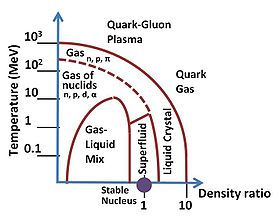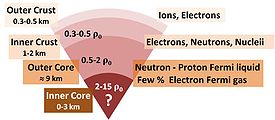
Nuclear matter
Encyclopedia

Proton
The proton is a subatomic particle with the symbol or and a positive electric charge of 1 elementary charge. One or more protons are present in the nucleus of each atom, along with neutrons. The number of protons in each atom is its atomic number....
s and neutron
Neutron
The neutron is a subatomic hadron particle which has the symbol or , no net electric charge and a mass slightly larger than that of a proton. With the exception of hydrogen, nuclei of atoms consist of protons and neutrons, which are therefore collectively referred to as nucleons. The number of...
s) that exists in several phase
Phase (matter)
In the physical sciences, a phase is a region of space , throughout which all physical properties of a material are essentially uniform. Examples of physical properties include density, index of refraction, and chemical composition...
s that as yet are not fully established. It is not matter in a nucleus, but a hypothetical substance consisting of a huge number of protons and neutrons interacting by only nuclear force
Nuclear force
The nuclear force is the force between two or more nucleons. It is responsible for binding of protons and neutrons into atomic nuclei. The energy released causes the masses of nuclei to be less than the total mass of the protons and neutrons which form them...
s and no Coulomb forces.Volume and the number of particles are infinite, but the ratio is finite. Infinite volume implies no surface effects and translational invariance (only differences in position matter, not absolute positions).
A common idealization is symmetric nuclear matter, which consists of equal numbers of protons and neutrons, with no electrons.
When nuclear matter is compressed to sufficiently high density, it is expected, on the basis of the asymptotic freedom
Asymptotic freedom
In physics, asymptotic freedom is a property of some gauge theories that causes interactions between particles to become arbitrarily weak at energy scales that become arbitrarily large, or, equivalently, at length scales that become arbitrarily small .Asymptotic freedom is a feature of quantum...
of Quantum chromodynamics
Quantum chromodynamics
In theoretical physics, quantum chromodynamics is a theory of the strong interaction , a fundamental force describing the interactions of the quarks and gluons making up hadrons . It is the study of the SU Yang–Mills theory of color-charged fermions...
, that it will become quark matter, which is a degenerate Fermi gas of quarks.

Neutron star
A neutron star is a type of stellar remnant that can result from the gravitational collapse of a massive star during a Type II, Type Ib or Type Ic supernova event. Such stars are composed almost entirely of neutrons, which are subatomic particles without electrical charge and with a slightly larger...
, which requires more than neutrons and protons, is not necessarily locally charge neutral, and does not exhibit translation invariance, often is differently referred to, for example, as neutron star matter or stellar matter and is considered distinct from nuclear matter. In a neutron star, pressure rises from zero (at the surface) to an unknown large value in the center.
Methods capable of treating finite regions have been applied to stars and to atomic nuclei. One such model for finite nuclei is the liquid drop model, which includes surface effects and Coulomb interactions.
See also
- QCD vacuumQCD vacuumThe QCD vacuum is the vacuum state of quantum chromodynamics . It is an example of a non-perturbative vacuum state, characterized by many non-vanishing condensates such as the gluon condensate or the quark condensate...
- Quark-gluon plasmaQuark-gluon plasmaA quark–gluon plasma or quark soup is a phase of quantum chromodynamics which exists at extremely high temperature and/or density. This phase consists of asymptotically free quarks and gluons, which are several of the basic building blocks of matter...
- Degenerate matterDegenerate matterDegenerate matter is matter that has such extraordinarily high density that the dominant contribution to its pressure is attributable to the Pauli exclusion principle. The pressure maintained by a body of degenerate matter is called the degeneracy pressure, and arises because the Pauli principle...
- Neutron-degenerate matter
- Strange matterStrange matterStrange matter is a particular form of quark matter, usually thought of as a "liquid" of up, down, and strange quarks. It is to be contrasted with nuclear matter, which is a liquid of neutrons and protons , and with non-strange quark matter, which is a quark liquid containing only up and down quarks...
- Nuclear structureNuclear structureUnderstanding the structure of the atomic nucleus is one of the central challenges in nuclear physics. This article is written from a nuclear physics perspective; as such, it is suggested that a casual reader first read the main nuclear physics article....
- NeutroniumNeutroniumNeutronium is a proposed name for a substance composed purely of neutrons. The word was coined by scientist Andreas von Antropoff in 1926 for the conjectured "element of atomic number zero" that he placed at the head of the periodic table...
- Nuclear physicsNuclear physicsNuclear physics is the field of physics that studies the building blocks and interactions of atomic nuclei. The most commonly known applications of nuclear physics are nuclear power generation and nuclear weapons technology, but the research has provided application in many fields, including those...

